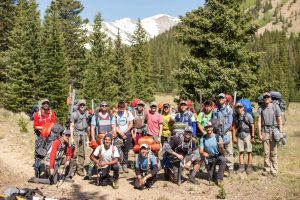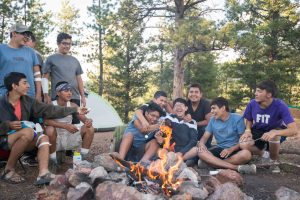Do you remember who or what first sparked your interest in the great outdoors? Many of us have a story of how someone helped us connect to the wilderness. As a result of this connection, many of us now also have stories of how we’ve overcome adversity, taken on a leadership role, or learned how to better cope with the stresses of daily life. However, finding this type of mentorship rooted in the outdoors can be much harder for some youth to find, especially those growing up in more urban areas without access to the necessary gear or role models for learning the magic of a night out in the woods.
Explore Austin is looking to break down the barriers youth face in getting involved with outdoor adventure. Through mentoring, leadership opportunities, and outdoor excursions, the Texas-based nonprofit empowers youth to reach their full potential.
Laura Nettleton is the Director of Development at Explore Austin, and an avid outdoorswoman herself. She is one of the several inspiring members of this nonprofit team that is helping shape Gossamer Gear’s partnership with Explore Austin in support of youth within our community.
Interview with Laura Nettleton on Explore Austin’s Mission to Empower Youth
We caught up with Laura to learn a little more about Explore Austin’s mission-driven work, the importance of providing wilderness opportunities to youth, our new partnership with the organization, and how you can get involved, too.
Gossamer Gear: Can you start by telling us a little background on Explore Austin?
Laura: Explore Austin began in 2006 when three Austinites, inspired by their own mentors and their love for the outdoors, committed to a six-year journey to empower youth in our community. Our founders recognized that by combining the benefits of mentoring and outdoor adventure, they could inspire youth, whom we call “Explorers,” to look inward and build off their own self-confidence, leadership skills, and develop a sense of responsibility for themselves, their community, and nature.
Today, we serve over 300 youth (7th through 12th grade boys and girls) and have 100 volunteer Mentors who each commit six years to the program. Our teams of youth learn year-round, specific outdoor skills like mountain biking, rock climbing, backpacking, paddling, and orienteering through monthly Saturday Challenges and weeklong backcountry trips to places like Wyoming, Arkansas, Colorado, New Mexico, and Oklahoma.
What makes Explore Austin’s youth programming unique?
Explore Austin utilizes several unique components to our programming, including long-term, group mentoring, our very own ACES (Action-Oriented, Courageous, Excellent Teammate, Strong Communicator) leadership curriculum, our depth of activities, and, finally, our combination of mentoring and outdoor adventure. I’ll focus on the long-term, group mentoring and our combination of the outdoors and community.
We pair each class of fifteen seventh grade Explorers with five adult Mentors to form one team that stays together all six years. This 3:1 ratio allows for intimate group dynamics with the benefits of teamwork, social-emotional learning, and leadership opportunities often lacking in the 1:1 model. We continue to maintain high retention of both Explorers and Mentors (90% or more), which I’d attribute to the group bonding of this component.
I’m a firm believer that the outdoors is the master at teaching us all our full potential. By pairing mentoring and adventure together, we help youth and our volunteer Mentors create reference points in their lives where they’ve overcome challenges and had a community to share in that, too. The outdoors serves us a platter of unpredictability, and our program provides opportunities where youth have adapted through some of the toughest, coldest, wettest, and most mosquito-filled days. Once youth prove to themselves they’ve done it once, that’s all they need for it to translate into other areas of their lives. I think Explore Austin is at its best in these moments of challenge in uncovering to youth that they’ve always had it in them to adapt and press on.

How do you select youth for the program and make sure they’re connected to the best mentor?
We work with partnership schools across Austin including KIPP, Wayside, Austin Achieve, and Austin ISD to first let youth know about our program. While we do have an application youth fill out, we primarily use this to understand a youth’s motivation to be in the program, let them and their families know of the six-year commitment, and screen for youth qualifying for free or reduced lunch. While youth can be in the program even if they do not meet this qualification, we do give preference to it.
Mentors also go through an application process that is more in-depth and includes background checks, reference checks, in-person interviews, and more. We do consider complementary personalities to teams when we match them, however, we also believe that adapting and learning to work with different personalities and backgrounds is an important part of what we do. So, we don’t necessarily match a youth with an exact mentor or team.
Do you have a story you can share of a youth from the program that really demonstrates the power of this outdoor-focused mentorship?
Last year, I was on a Summer Wilderness Trip backpacking with the Girls Arrows team in Colorado. One Explorer, Eva, was slow and methodical in how she hiked. We, as the team Mentors, knew Eva had more in her. We also knew Eva sets the pace in energy, too, for the group, and at the time, her energy was having a negative impact.
After hiking six miles and a few thousand feet of elevation and doused in rain, we set up camp. Knowing the next morning we’d have an alpine start, two Mentors pulled Eva aside to check-in. Instead of coming down on her, they focused on Eva’s ability to energize the team and affirmed their belief in her that she could pick up the pace. Our biggest concern was that Eva’s hiking earlier would create a precarious weather situation the next day if we were summiting the planned peak too late.
Initially, Eva didn’t believe she could do it. The Mentors kept emphasizing their belief in her, catalyzing the belief in herself. Given the option to either stay back and not do the summit or wake up a little earlier and get a head start, Eva chose the latter. The next morning, Eva submitted the 12,000-foot peak with the whole team. She held her arms high above her head letting the brisk wind brush her face, shared in the accomplishment with her peers, and smiled in pride. In that moment, I saw the art of mentoring meet a young woman’s nurtured belief in self.

What are some of the barriers youth in Austin face to getting outside, and how do you support them through those?
Austin is one of the top economically segregated cities in the county. If you look back at our city’s history, you will find that Austin redlined certain areas of our city in the 1920s and 1930s that limited not just economic development and generational wealth for black and brown communities, but access to well-kept green spaces, too. These systematic barriers continue on up to today.
I-35 is the tangible wrinkle in our history where we clearly can see how systemic policies and park placement impact our city still. Why this matters to Explore Austin and how it affects the youth we serve and their access to outdoor spaces is particularly important to us. We primarily serve black and brown youth, who as a group remain underrepresented in access to green spaces.
There is growing research which connects how contact with nature and social-economic status impacts overall well-being. We know that the outdoors provides a myriad of positive benefits, including reduction of stress and cognitive fatigue, and enhancements in creativity and restoration.
Many of the youth we serve have never been to the Greenbelt or even knew about Walnut Creek. This isn’t a result of lack of interest in the outdoors. It reflects a complex system of access, early childhood experiences in the outdoors, cultural factors, and discrimination. We have to acknowledge that both health status and economic status and our environment are intricately woven together. Austin has a long way to go in terms of equity, representation, and inclusion in green spaces, and we hope that as a program we are part of that solution.
How are you hoping this partnership with Gossamer Gear will strengthen the services you’re able to offer?
Partnering with Gossamer Gear, we hope, helps elevate both missions to get people outside — and particularly for us, youth. While Gossamer Gear focuses on doing more with less, Explore Austin focuses on doing more with community. I think both center around enhancing well-being. We all know that certain outdoor activities aren’t always affordable or easily accessed. We also know that our outdoor experiences can be enhanced with the right gear and the right people. I see our partnership magnifying Explore Austin’s ability to get youth outside with some of the best gear out there, ensuring the most enriched outdoor experiences while promoting the power of aligned missions to impact individual and community well-being.
Learn More About How You Can Support Youth Through Explore Austin
If you’re curious about getting involved with Explore Austin, such as becoming a Mentor or donating, you can learn more at: www.exploreaustin.org. You can also follow along with Explore Austin’s work on Facebook or Instagram. Still have questions? Feel free to drop a line to Laura Nettleton at: laura.nettleton@exploreaustin.org.
—
This article originally appeared on the Gossamer Gear blog, Light Feet.

